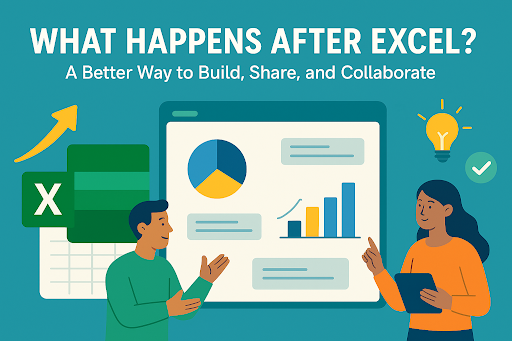Excel is the most popular tool to organize data, make calculations, and prepare reports that have been used for decades. Its flexibility, ease of use, and powerful features have made it invaluable in business, research, and personal use. It could be budgeting or complex financial models; Excel has helped millions of people to make informed decisions.
But with the increasing levels of collaboration and dynamic workflows, the conventional shortcomings in Excel have been evident. The most important pain points are the multiple versions, real-time work, and scaling of large data. The question is then, what happens after Excel? How do we keep the power of spreadsheets and enhance collaboration, security, and efficiency?
Challenges of Traditional Excel Usage
Excel is very flexible, yet there are many productivity limitations:
- Version hell: There are numerous versions of one file, which creates confusion and errors. A typical, yet brittle workaround, is to name files FINAL_v2_approved.xlsx.
- Inadequate cooperation: Simultaneous editing can be awkward and subject to conflicts, even when sharing cloud-based.
- Security threats: There are chances of copying or editing sensitive data without supervision.
- Scalability problems: This is because large and complex spreadsheets are slow, and thus, it is difficult to ensure data integrity.
“Excel is the Swiss Army knife of data, but it wasn’t designed to be a collaborative superhighway.” – Data Analyst, 2024
These pain points explain why organizations require a solution that is more than just a conventional spreadsheet.
Converting Excel into Web Apps
The best method of modernizing Excel is to turn spreadsheets into web applications. Such a method maintains formulas and structure but offers a more collaborative, secure and accessible platform.
You can learn how to convert Excel files into web apps on this website. The benefits include:
| Benefit | Description |
| Centralized access | All users work on the same live data |
| Role-based permissions | Control who can view or edit data |
| Mobile accessibility | Access spreadsheets from any device |
| Automated updates | Changes go live instantly |
| Enhanced security | Encryption and monitoring for sensitive data |
Practical Uses
- Inventory management: Updating the current stock levels in different locations in real time.
- Financial planning: Budget and forecasts on one platform.
- Lead tracking: Track customers and create reports without duplicating files.
“They’re not just riding the wave of digital culture—they’re shaping the tide.” – Culture Writer, 2024
Transforming Excel into a web app limits errors, enhances accessibility and facilitates collaboration.
Version Control: Solving Excel’s Biggest Problem
Another major challenge in Excel is version management. Multiple file versions create confusion, lost data, and slow decision-making.
Using solutions like Control versions Excel ensures a single source of truth. Key features of modern version control include:
| Feature | Benefit |
|---|---|
| Single source of truth | Everyone accesses the latest data |
| Audit trails | Track who changed what and when |
| Revert options | Restore previous versions easily |
| Conflict prevention | Real-time editing avoids overwriting |
| Collaboration | Multiple users can work simultaneously |
“Version control transforms Excel from a static file into a living, auditable, and secure platform.” – Project Manager, 2024
Version control helps to get rid of chaos, minimize errors, and guarantee that teams work with the most correct data at all times.
Why Moving Beyond Excel Matters
Transitioning from traditional spreadsheets to web apps with version control doesn’t discard Excel—it amplifies its power. Organizations gain:
- Fewer errors: Centralized updates reduce mistakes from outdated files.
- Quicker decision-making: Real-time information is faster, thus responsive.
- Enhanced security: There is enhanced security through role-based access to sensitive information.
- Scalability: Web apps handle growing datasets and teams efficiently.
- Enhanced teamwork: Teams work together on real-time data, and this enhances the workflow.
Real-World Examples
- Retail Inventory: A retail chain of stores substituted emailed spreadsheets in Excel with a live web application. Inventory levels were refreshed in real-time, and stockouts and planning were improved.
- Finance Forecasting: A finance team has moved their complex models to a version-controlled platform and eliminated the multiple-versions of files, and decreased errors by 70 percent.
- University Data Collection: The answers of the students were gathered in a web app rather than in a large number of spreadsheets and the administrators could see a holistic image in real time.
Tips for a Smooth Transition:
Here are some tips for a smooth transition, you have to consider before transforming
- Watch out for useful files to convert.
- Begin with the attack processes with many users.
- This must be one that can support the Excel formulas and the workflow requirements.
- Provide instructions on how to adapt to new systems.
- Take action on the feedback and refine the solution.
Conclusion
Excel will never stop being a strong tool, but it does not need to be the end. Organizations can convert their spreadsheets into web applications, incorporate version control and make their work smarter, collaborative and secure.
Leaving Excel is not about leaving it; it is about complementing its capabilities, removing errors, and letting teams work faster and more efficiently. The future is in connected, controlled and collaborative platforms, with the spreadsheets becoming interactive and trusted tools of the modern work.
“Excel is no longer the endpoint. It’s the starting line for innovation.” – Technology Strategist, 2024

